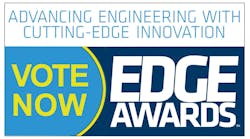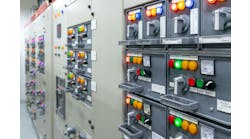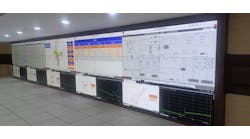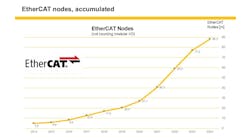Read Andrew Bond’s Industrial Automation Insider, a monthly newsletter covering the important industrial automation news and issues as seen from the U.K.
By Andrew Bonds
CONTROL magazine’s seasonal gift to its readers at the end of 2007 was its annual Top 50 listing of Process Automation companies, once again compiled in conjunction with ARC. In fact, as in 2006, this was something of a misnomer since Editor in Chief Walt Boyes and his ARC collaborator, Larry O’Brien, have, for the second year in succession, abandoned any attempt to distinguish between process and discrete automation and have instead chosen to count in everything they deem to be automation of any kind. That certainly makes sense with vendors such as Rockwell and GE Fanuc making increasingly serious and effective attempts to establish themselves in the process sector. On the other hand, given the ongoing and near universal trend towards integration, their decision to exclude supply chain management software, building automation systems and fire and security systems from their definition seems a trifle arbitrary.
Global nod
Working on the same basis in successive years should have made year on year comparisons more realistic, were it not for the fact that they appear to have changed the method of compiling the respective figures for the North American and Global markets. “Instead of just doing a North American Top 50, with a nod of the head to global results,” they say, “we’ve decided we need to produce two lists: A Global Top 50 that shows the real performance of the flat world of automation, and a North American Top 50, with numbers derived from global performance.” Quite how that affects the actual figures is not clear, at least to this observer, but it does suggest that any subsequent analysis needs to be considered with a degree of caution.
With that public health warning in mind then, how did the runners and riders finish in 2006, the year on which these latest figures are based? In the North American market, where the revenues of the Top 50 totalled $20.1bn, the top four remain unchanged with Emerson still leading the pack with total revenues of $2.9bn, Rockwell running second with $2.3bn, ABB third with $1.7bn and Honeywell fourth with £1.6bn.
Lower down there’s signs of change, however. Moving up into fifth place from seventh last time is Schneider with revenues of $1.2bn while last year’s fifth, Siemens, drops to sixth with $1.1bn. Up from eighth to seventh is GE at $1.0bn while Invensys drops two places to eighth with $0.9bn.
New to the Top 10 at ninth and tenth respectively are Danaher, and Cameron Valves & Measurement, both with North American Revenues of $0.7bn. Out of the Top 10 go Ametek which dropped to 11th and ThermoElectronic, now merged with Fisher Scientific, which dropped right down to 27th.
Closing the gap
In the Global market, where the revenues of the Top 50 totalled $65bn, Siemens still leads with total automation revenues of $8.6bn but ABB is running a closer second on $7.7bn. Displacing Emerson from third place is Schneider with revenues of $5.5bn with Emerson in fourth on $5.4bn. Fifth and sixth for a second year are respectively Rockwell, with $3.6bn, and Honeywell with $3.1bn.
Moving up two places to seventh is Yokogawa with $2.7bn, while Omron on $2.6bn drops one place to eighth. Also dropping a place from eight to ninth is Invensys with $1.9bn while a newcomer to the Top 10, Mitsubishi takes tenth place, also on $1.9bn. Pushed out of the Top 10, albeit only into 11th place, is GE.
Rather than simply plagiarizing Boyes’ and O’Brien’s hard work, INSIDER has again sought to add a little further value by deriving a pecking order for the market outside North America from their data. With Middle Eastern and Far Eastern markets providing the lion’s share of current growth this gives perhaps the strongest indication of who’s really winning and losing in the battle for automation supremacy. As our table shows, Europe’s two giants, Siemens and ABB, continue to lead the field with Schneider serving only to emphasize European domination in third place. Indeed European vendors account for more than 40% of the ‘Rest of the World’ revenues of the Top 50 contenders. Perhaps more significant, however, given Yokogawa’s well publicized ambitions in the process automation sector, is the solid phalanx of Japanese vendors in fifth, sixth and seventh places. Emerson continues to fly the flag as the only North American contender in the top five but out of the Top 10 entirely goes Invensys.
Boyes and O’Brien are once again to be congratulated on their attempt at the impossible. Where however we might take issue with them is on their related crystal ball gazing both in their article Who's Winning? and in the associated podcast Top 50 Process Automation Companies where they seem to be implying that the automation industry in general and the process automation industry in particular will be immune to the effects of the economic storms which are now brewing. Because projects are being deferred beyond 2010 and even 2015 because of shortages of resources and, in particular, of experienced engineers, we can, they argue, be confident that the current buoyancy will continue for the foreseeable future. Historical precedent would suggest that, in the face of a global recession which now threatens, and which has if anything become more certain since their article was published in early December, projects deferred to that degree should more correctly be regarded as shelved if not killed.
on the 2007 Top 50 automation companies,
read the article Who's Winning?





